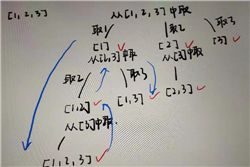标签:取值 info public 节点 pat void problem 不能 length
给你一个整数数组 nums ,数组中的元素 互不相同 。返回该数组所有可能的子集(幂集)。
解集 不能 包含重复的子集。你可以按 任意顺序 返回解集。
示例 1:
输入:nums = [1,2,3]
输出:[[],[1],[2],[1,2],[3],[1,3],[2,3],[1,2,3]]
示例 2:
输入:nums = [0]
输出:[[],[0]]
来源:力扣(LeetCode)
链接:https://leetcode-cn.com/problems/subsets
著作权归领扣网络所有。商业转载请联系官方授权,非商业转载请注明出处。
1.枚举所有的子集,可以使用回溯法。
2.[1,2]与[2,1]是一个解,说明是一道组合问题。
3.从一个集合中取值,说明需要startIndex来标识取值区间。
先抽象成树

可以看出和之前组合题不同的地方是这道题每一个节点都要放在结果集
递归的参数和返回值
startIndex:控制取值区间
nums:接收输入的数组
List<List<Integer>> res = new ArrayList<>();
List<Integer> path = new ArrayList<>();
void backtracking(int[] nums,Int startIndex);
递归终止条件
取到nums的最后一个值之后就可以停止递归了
if(startIndex==nums.length){
return;//startIndex >= nums.length时不会进入循环说明这次递归结束,所以这个条件也可以省略
}
单层递归逻辑
每一条路径往下走的时候,先把节点加入结果集。
void backtracking(int[] nums,int startIndex){
if(startIndex==nums.length)
return; //startIndex >= nums.length时不会进入循环说明这次递归结束,所以这个条件也可以省略
res.add(new ArrayList(path));//每次递归往下走之前都把树的节点加入结果集
for(int i=startIndex;i<nums.length;i++){
path.add(nums[i]);
backtracking(nums,i+1);
path.remove(path.size()-1);
}
代码
class Solution {
List<List<Integer>> res = new ArrayList<>();
List<Integer> path = new ArrayList<>();
public List<List<Integer>> subsets(int[] nums) {
res.add(new ArrayList(path));
backtracking(nums,0);
return res;
}
void backtracking(int[] nums,int startIndex){
//每次递归往下走之前都把树的节点加入结果集
res.add(new ArrayList(path));
for(int i=startIndex;i<nums.length;i++){
path.add(nums[i]);
backtracking(nums,i+1);
path.remove(path.size()-1);
}
}
}
标签:取值 info public 节点 pat void problem 不能 length
原文地址:https://www.cnblogs.com/rananie/p/14860228.html